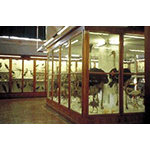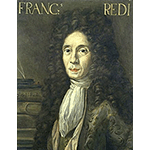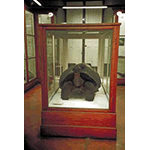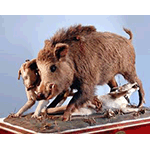Zoology in Tuscany

The number and antiquity of the zoological and paleo-anthropological specimens present in Tuscany result from a tradition of studies whose roots go back to the 16th century. The first random finds of fossilised bones and the importing of rare, exotic animals, appreciated above all for their "strangeness", were followed in time by collections that were increasingly well-organised and systematic in the number and species of animals represented. From these bases the teaching of zoology as an independent branch of scientific knowledge was to begin in Tuscany already in the early 19th century.

Zoology in the 16h century
Around the middle of the 16th century the French naturalist Guillaume Rondelet, author of a famous treatise on fish, travelling through Florence, observed the carcass of a sperm whale exhibited under the Loggia dei Lanzi: the fetid smell emitted by the body of the gigantic cetacean, which had washed up on the coast near Pisa, did not hinder the amazement and enthusiasm of the citizens. During his stay in Florence 1577, the great Bolognese naturalist Ulisse Aldrovandi noted the vast number of specimens of fish and other animals in the grand-ducal collections and the private "cabinets of curiosities". Aldrovandi exchanged information and pictures of the rarest and strangest animals with Grand Dukes Francis I and Ferdinand I de' Medici: poisonous snakes, felines, monstrous animals, surprising fish, even the spectacular "great beast", the moose. During those years, in the Florentine Court, Iacopo Ligozzi was charged with painting the specimens kept in the grand-ducal "serragli", or menageries, located in Piazza San Marco. It was expressly in the grand-ducal "serragli" that the famous anatomist Gabriele Falloppio performed dissection on lions to demonstrate, contrary to what had been stated by Aristotle, that the bones of the ferocious animal are hollow.

Zoology in the 17th century
In the 17th century the heritage of Galileo, passed down by the Accademia del Cimento, was received by Francesco Redi. Using the instruments found in the Court collections, Redi conducted important observations under the microscope. In his Esperienze intorno alla generazione degli insetti (experiments on the generation of insects) published in 1668, he refuted the age-old theory of the spontaneous generation of insects, according to which animals could be generated from the soil or from rotting substances, though an ingenious experiment that introduced into the scientific method the serial procedure and comparison between research experiments and control experiments.
In 1677 Grand Duke Cosimo III had a menagerie, or "serraglio", built in the Boboli Gardens. It held lions, ostriches, camels, monkeys and parrots, which were studied by Francesco Redi and portrayed by Bartolomeo Bimbi and Andrea Scacciati. In 1682, at the advice of Lorenzo Magalotti, the Grand Duke purchased the collection of seashells owned by the Dutch naturalist Georg Eberhard Rumph.

Zoology in the 18th century
In the century of Enlightenment, numerous initiatives were carried out in the zoological field. In 1742 the Index Testarum Conchyliorum by Niccolò Gualtieri, physician to the Medici family and professor in Pisa, was published in Florence. The splendid plates drawn by Giuseppe Menabuoni reproduced specimens some of which are still conserved today in the Pisa Museum of Natural History. Between 1767 and 1776 the monumental Storia naturale degli Uccelli (natural history of birds) by Saverio Manetti, dedicated to Grand Duke Peter Leopold, was published. In 1775, with the founding of the public Museo di Fisica e Storia Naturale in Florence, directed by Felice Fontana, Tuscany took its place in the vanguard of Europe in scientific research. Today the "Specola" Museum is heir to the zoological specimens.

Zoology in the 19th century
In the early 19th century, university teaching of natural history was divided into various specific disciplines, and zoology acquired the status of an independent science. In Florence, the teaching of zoology was entrusted to Attilio Zuccagni and Filippo Nesti, while in Pisa this chair was assigned to Paolo Savi, curator of the Museum of Natural History. During the same period, veterinary science also became an independent discipline.
Zoological collections today
The historical development of zoology in Tuscany is documented by prestigious museums, often inserted in extraordinary historical contexts, such as the Museo di Storia Naturale e del Territorio at Calci, the Museo Anatomico Veterinario in Pisa, the Zoology Section ("La Specola") of the University of Florence Museo di Storia Naturale, the Museo di Storia Naturale dell'Accademia dei Fisiocritici in Siena, and the naturalist collection of the Liceo Classico "Nicolò Machiavelli" in Lucca.
Some of the more recently established museums and centres are also particularly interesting. Noteworthy among these are the Centro di Scienze Naturali of Galceti, the Museo di Storia Naturale della Lunigiana at Aulla, the Museo di Storia Naturale del Mediterraneo and the "Diacinto Cestoni" Municipal Aquarium in Livorno, the Museo del Mare at Piombino and the Museo di Storia Naturale della Maremma in Grosseto.
Lastly, numerous collections are destined mainly to divulging and to specific aspects of zoology, in particular, the Museo Ornitologico "Carlo Beni" at Stia, the Lensi Ornithological Collection in the Fucecchio Museum, the Museo Civico Zoologico at Capannoli, the Museo Civico di Scienze Naturali e Archeologia della Valdinievole at Pescia, the Centro Espositivo di Scienze Naturali at Torre del Lago Puccini, the Museo di Storia Naturale at Rosignano Solvay, the Museo Ornitologico at San Gimignano and the Museo di Malacologia Terrestre at Sorano. Moreover, zoological specimens, collected for educational purposes, are frequently found in school collections.
-
 Acquario Comunale 'Diacinto Cestoni' ['Diacinto Cestoni' Communal Aquarium]
Acquario Comunale 'Diacinto Cestoni' ['Diacinto Cestoni' Communal Aquarium] -
 Centro di Scienze Naturali di Galceti [Galceti Natural Science Centre]
Centro di Scienze Naturali di Galceti [Galceti Natural Science Centre] -
 Centro Espositivo di Scienze Naturali [Natural Science Exhibition Centre]
Centro Espositivo di Scienze Naturali [Natural Science Exhibition Centre] -
 Liceo Classico 'Niccolò Machiavelli' ['Niccolò Machiavelli' Classical Secondary School]
Liceo Classico 'Niccolò Machiavelli' ['Niccolò Machiavelli' Classical Secondary School] -
 Museo Civico di Scienze Naturali e Archeologia della Valdinievole [Valdinievole Civic Museum of Natural Science and Archaeology]
Museo Civico di Scienze Naturali e Archeologia della Valdinievole [Valdinievole Civic Museum of Natural Science and Archaeology] -
 Museo Civico Zoologico di Capannoli - Villa Baciocchi [Zoological Civic Museum of Capannoli - Villa Baciocchi]
Museo Civico Zoologico di Capannoli - Villa Baciocchi [Zoological Civic Museum of Capannoli - Villa Baciocchi] -
 Museo del Mare - Istituto di Biologia ed Ecologia Marina [Museum of the Sea - Institute of Biology and Marine Ecology]
Museo del Mare - Istituto di Biologia ed Ecologia Marina [Museum of the Sea - Institute of Biology and Marine Ecology] -
 Museo di Fucecchio [Fucecchio Museum]
Museo di Fucecchio [Fucecchio Museum] -
 Museo di Malacologia Terrestre [Museum of Terrestrial Malacology]
Museo di Malacologia Terrestre [Museum of Terrestrial Malacology] -
 Museo di Storia Naturale del Mediterraneo [Museum of Natural History of the Mediterranean]
Museo di Storia Naturale del Mediterraneo [Museum of Natural History of the Mediterranean] -
 Museo di Storia Naturale della Lunigiana [Lunigiana Museum of Natural History]
Museo di Storia Naturale della Lunigiana [Lunigiana Museum of Natural History] -
 Museo di Storia Naturale della Maremma [Maremma Museum of Natural History]
Museo di Storia Naturale della Maremma [Maremma Museum of Natural History] -
 Museo di Storia Naturale dell'Accademia dei Fisiocritici ['Accademia dei Fisiocritici' Museum of Natural History]
Museo di Storia Naturale dell'Accademia dei Fisiocritici ['Accademia dei Fisiocritici' Museum of Natural History] -
 Museo di Storia Naturale di Firenze - Sezione di Zoologia ('La Specola') [Museum of Natural History of Florence - Zoology Section ('La Specola')]
Museo di Storia Naturale di Firenze - Sezione di Zoologia ('La Specola') [Museum of Natural History of Florence - Zoology Section ('La Specola')] -
 Museo di Storia Naturale di Rosignano Solvay - Associazione 'Amici della Natura Rosignano' [Rosignano Solvay Museum of Natural History - 'Rosignano Friends of Nature' Association]
Museo di Storia Naturale di Rosignano Solvay - Associazione 'Amici della Natura Rosignano' [Rosignano Solvay Museum of Natural History - 'Rosignano Friends of Nature' Association] -
 Museo di Storia Naturale e del Territorio di Calci [Museum of Natural History and of the Calci Territory]
Museo di Storia Naturale e del Territorio di Calci [Museum of Natural History and of the Calci Territory] -
 Museo Ornitologico [Ornithological Museum]
Museo Ornitologico [Ornithological Museum] -
 Museo Ornitologico 'Carlo Beni' ['Carlo Beni' Ornithological Museum]
Museo Ornitologico 'Carlo Beni' ['Carlo Beni' Ornithological Museum] -
 Università degli Studi di Pisa - Dipartimento di Anatomia, Biochimica e Fisiologia Veterinaria - Museo Anatomico Veterinario [University of Pisa - Department of Veterinary Anatomy, Biochemistry and Physiology - Veterinary Anatomical Museum]
Università degli Studi di Pisa - Dipartimento di Anatomia, Biochimica e Fisiologia Veterinaria - Museo Anatomico Veterinario [University of Pisa - Department of Veterinary Anatomy, Biochemistry and Physiology - Veterinary Anatomical Museum]
****************************
Texts by Alessandro Tosi
English translation by Catherine Frost
Last update 09/feb/2008


